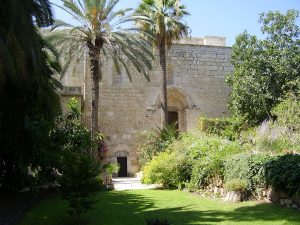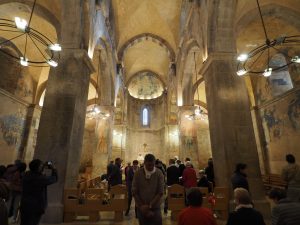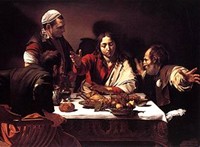28 As they came near the village to which they were going, he walked ahead as if he were going on. 29 But they urged him strongly, saying, “Stay with us, because it is almost evening and the day is now nearly over.” So he went in to stay with them. 30 When he was at the table with them, he took bread, blessed and broke it, and gave it to them. 31 Then their eyes were opened, and they recognized him; and he vanished from their sight. 32 They said to each other, “Were not our hearts burning within us while he was talking to us on the road, while he was opening the scriptures to us?” 33 That same hour they got up and returned to Jerusalem; and they found the eleven and their companions gathered together. 34 They were saying, “The Lord has risen indeed, and he has appeared to Simon!” 35 Then they told what had happened on the road, and how he had been made known to them in the breaking of the bread. [Luke 24:28-35, NRSV]
The Resurrection Church in Abu Gosh; church interior [Photo: Dr. LL Chan]; Supper at Emmaus, by Caravaggio, 1601.
The Resurrection Church in Abu Gosh, also known as the Church of the Crusaders in Abu Gosh, is the name given to a church that marks a place believed to be Emmaus described in Luke 24. Located about 6.2 miles from Jerusalem, it forms part of the Benedictine monastery of St. Mary of the Resurrection in Abu Gosh, in central Israel.
During our visit, a Mass in progress prevented us from entering the church for quite some time.
Reflection:
While waiting, we recalled that the ending in the narratives of all the four Gospels are framed as, in a sense, a new beginning. They give ample hints that as the narratives draw to a close, this would just be the start of a whole new phase of life and work for all who would be disciples of Jesus of Nazareth. Mark’s Gospel did not end with the women “saying nothing to any one, for they were afraid” (Mark 16:8). “Saying nothing” could not possibly be the last word of the Good News of Jesus Christ who had already announced “the truth” at his anointing by a woman at Bethany that “wherever the gospel is preached in the whole world, what she has done will be told in memory of her” (Mark 14:9). Matthew ends his Gospel with Jesus sending his disciples out on a mission, promising his presence and company “to the end of time” (Matthew 28:20). In John’s Gospel, readers are treated to a potent future-pointing picture encapsulated in Jesus’ words. Peter asks Jesus about his assignment for John, and Jesus answers thus: “If it is my will that he remain until I come, what is that to you?” (John 21:23). It is Luke’s Gospel, however, that detained our imagination while we stood there waiting. More than just future-looking, Luke’s narrative on what has become popularly known as the Emmaus Walk (Luke 24:13-35) portrays an unrepeatable moment which nevertheless would be the model for subsequent Christian experience. As the event launched God’s renewed people in Israel two thousand years ago, so will it launch contemporary Christians of the twenty-first century, and of every subsequent century, on a path of authentic, kingdom-promoting life of discipleship.
Concerning this model, three elements in particular stand out for reflection. It is evidently the intention of the Risen Lord that in combination, these three elements set the pattern for the way He will be known from then on.
1. Breaking Open the Scriptures
The Risen Christ, yet unrecognized, pulled up alongside the two dispirited disciples. The first thing he did was to break open the Word of the Scriptures to them. The method and style of his exposition, and the substance of his analysis, caused their hearts to burn inside them. In turn, later, upon recognizing the Lord, they would dash back to Jerusalem to spread the good news, their hearts burning with immense excitement.
Patently, there is no “good news” to preach on or to speak about, if the Word is not first properly broken open to the listeners. If the people are not properly fed by the Word through competent reflection and explanation, they will not be excited with their faith and their ability to pass on the Word would be seriously curtailed.
2. Blessed Presence of the Lord in the Breaking of the Bread
The Resurrected Christ sets the pattern in this narrative that he will be recognized at the breaking of the bread. In so indicating the pattern here, Luke points forward to Acts of the Apostles 2:42 where the renewed community of the Crucified and Risen Lord would present the marks of the church as:
- devotion to the Apostles’ teaching;
- fellowship;
- breaking of bread; and
- prayers.
3. Reaching Out in Generosity to Anyone in Need
Emmaus witnesses to a unique moment: from deep sadness of loss and defeat to extraordinary joy; from feelings of utter darkness to the unimaginable delight of revelation; from pain to hope; and ultimately from death to new life.
Of course the wholly “new” exposition of the Bible by the Lord has been one of two absolutely essential elements in this journey from darkness to light for the two disciples, the other being his real presence at the communal breaking of the bread. That having being said, however, something else had to happen before the two disciples could, in their agitated astonishment, discuss the way the Lord’s “new” exposition of the Scriptures had caused their hearts to burn inside them, and recognize the Lord at the breaking of the bread. That something holds the key, acts as the bridge, and is the linchpin in this pattern of revelation:
- It is the generous action of the two disciples who, in seeing that the day was nearly over so that the stranger would need a place to eat and rest for the night, went out of themselves and offered kindness to a fellow traveler who was in need.
This narrative affirms that generosity stands at the origin of the Lord’s surprise gift of consolation and heightened presence. This teaches us, amongst other things, a pastoral wisdom in which a person depressed by grievous suffering is best led out of his or her suffering by getting them to come out of their self-enclosed and alienating sorrows and to go into helping others who are suffering and in need. Then, mysteriously in God’s wonderful design:
- in rendering help to others in need of help, they are helped;
- in bringing consolation to others who need consolation, they are consoled;
- in losing themselves for others, they will find themselves in Christ’s love.
In offering the episode of the Emmaus Walk to the faith community, Luke is saying that the Risen Lord and Christ has set a pattern that constitutes the central features of the life of the community that accepts Him as the way, the truth and the life.
Copyright © Dr. Jeffrey & Angie Goh, May 2019. All rights reserved.
You are most welcome to respond to this post. Email your comments to jeffangiegoh@gmail.com. You can also be dialogue partners in this Ephphatha Coffee-Corner Ministry by sending us questions for discussion.



